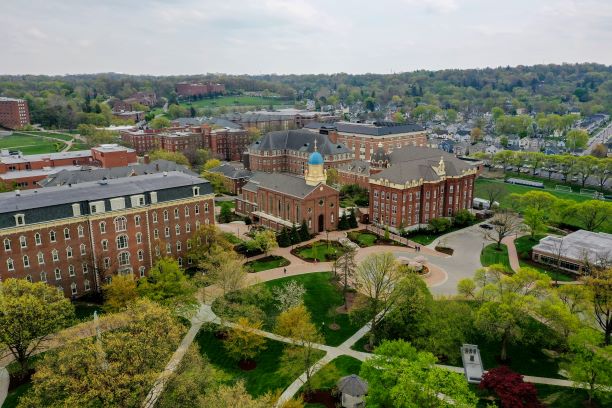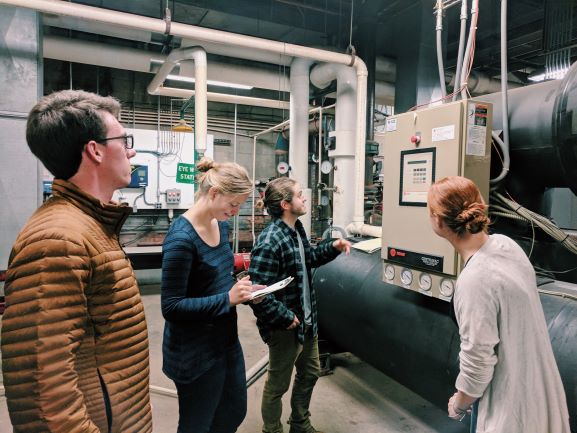
Energy & Sustainability
UD Energy Management
The energy management team oversees UD's multi-million dollar energy and utility program. More than 75% of UD's greenhouse gas emissions footprint is a result of the university's energy consumption. Over the past 10 years, the energy management team has reduced greenhouse gas emissions by 20%. The energy team also works with faculty, staff, and students educating the community on energy issues and providing hands-on learning opportunities for UD students.

The energy management team in Facilities Management is responsible for reducing the University's energy budget using strategies that are both technical and creative, without negatively impacting the comfort and convenience of the campus community.
With the goal of improving energy efficiency to reduce our energy consumption, the energy management team regularly evaluates energy intensive uses such as lighting, HVAC, and the central steam plant for energy efficiency opportunities.
The Demand Response program is a way you can help the University save money during the hot summer months. The University's energy supplier provides a financial incentive to reduce power usage during peak demand times on hot and very cold days. In addition to a financial incentive to UD, the Demand Response program supports the effective functioning of the electric grid during heavy load times, reducing the likelihood of regional brown-outs and black-outs. UD's energy managers work with many buildings on campus during peak demand to reduce our load during these times.
What Can I do to Help?
- Avoid using space heaters. They consume 1.5 kW per hour and localized heating could cause adjacent space to be over-cooled.
- When not using the computer, use hibernate mode. The average desktop computer uses 115w while in use, but in hibernation, the computer does not consume any energy.
- Turn computers, printers, copiers, and other machinery off overnight and on weekends. If you must leave a CPU on, turn off the monitor.
- Instead of using the elevator, take the stairs. You’ll save energy and get some exercise. (The average office elevator consumes 350 watts of electricity to travel from one floor to the next, according to the U.S. Department of the Interior. That’s enough energy to light a 100-watt light bulb for 3.5 hours.)
- Turn off lights when not in use.
- Make use of natural lighting as much as possible by opening blinds or shades. Adjustable blinds can let in light while reducing glare. If the window is facing the sun, draw the shades closed to keep the room cooler and more comfortable in hotter months.
- During the winter, wear heavier clothing, and turn the thermostat down. For every degree the temperature is turned down, you save 5–6 percent on heating energy.
- Shorten showers. Showers account for 2/3 of water heating costs
- Close blinds (and windows) after sunset in the winter to keep in heat. Leave them open during summer days instead of turning on extra lights.
- Turn off computer monitors and hard drives when not in use. Set your computer monitor to sleep after 10 minutes of inactivity.
- Unplug appliances that are not being used. Most idle appliances—TVs, game stations, microwaves -- continue to consume energy when switched off and account for 5 percent of total domestic energy consumption.
- Turn off lights when no one is in the room. Ten percent of the average home's electricity costs can be controlled with the flip of a switch.
- The typical lab consumes four to five times more energy than the same-sized office or classroom.
- Chemical fume hoods are the biggest energy consumer in research settings. While it is important to have the sashes open to the proper location to protect lab personnel when using fume hoods, 20 percent (or more) in energy reductions can be achieved by closing the sashes when not in use.
- Unplug battery chargers and equipment when not in use.
- Turn off equipment when it is not in use and encourage others to do the same. For sophisticated equipment, make it simple for co-workers to turn off equipment by posting procedures for proper start-up and shutdown on or near equipment.
- Turn off centrifuges overnight and over the weekend.
- Provide freezers/refrigerators with proper spacing (2-3 inches minimum clearance from walls or obstructions).
- Eliminate unnecessary freezers/refrigerators by getting rid of items that are no longer needed and combining contents into fewer freezers/refrigerators. (Link to Specialty Recycling electronics for disposal).
- Instead of buying a freezer/refrigerator for additional space, eliminate old samples and solutions from existing freezers/refrigerators.
- Keep refrigerators and freezers organized (give each person a section) so that cleanup and removal of old samples is easier. Before a group moves out of your area, ask them to get rid of unnecessary samples and condense their items into the smallest space possible.
- When purchasing a new refrigerator, invest in an ENERGY STAR rated replacement.
- Cook with small appliances. Cook with your toaster oven, electric skillet and slow cooker for specialized jobs, rather than the range. Small appliances use less energy.
- Run cold water for disposal. Hot water requires energy to warm the water. Cold water saves energy and solidifies grease, moving it more easily through the garbage disposal and pipes.
- Run full loads. Always wait until you have a full load before running your dishwasher. Full loads use the same amount of hot water and energy as smaller loads. You run fewer loads and save energy.
- Don’t peek in the oven. Resist the urge to open the oven door while baking. Every time you peek, the temperature drops 25° F and requires additional energy to bring the temperature back up.
- Adjust the water level. If you have a washer that allows you to control the load’s water level, adjust the level according to laundry load size. You can save energy by using less hot water for small loads.
- Wash laundry in warm or cold water. Washing laundry with warm or cold water works your water heater less. Use hot water only when the greatest cleaning is needed.
- Don’t dry clothes excessively. Drying laundry excessively uses more energy than is needed and is hard on fabrics. If you purchase a dryer, get one with an electronic sensor that shuts off the dryer when clothes are dry.
- Use natural lighting. Open curtains and shades during the day instead of using lighting. Consider skylights and solar tubes during remodeling or new construction design. This allows the maximum use of natural daylight.
- Turn off lights. Turn off lights when not in use, even for short periods of time. Turning lights off and on uses less energy than if they are left on all the time.
- Cool only the rooms in use. Close unused rooms to keep cooled air in areas where it is most needed.
- Turn off electronics you are not using. Don’t leave electronics, such as televisions, stereos, and computers, on if you don’t need them – they produce heat. Extra heat requires more energy to power the air conditioner and increases cooling costs.
- Use ceiling fans for air circulation. In hot weather, set the ceiling fan direction to blow air down. The air moving across your skin creates a cooling effect, allowing you to raise the temperature on your thermostat and still feel cool. In cold weather, set the fan to blow toward the ceiling. This pushes warm air away from the ceiling and evenly distributes heat in the room.
- Turn down the thermostat when away. If you are going to be away for an extended period of time, turn your thermostat down to save energy but never lower than 40° F. If you have delicate houseplants, keep the setting at 50° F or higher.

